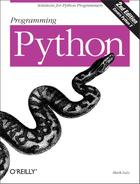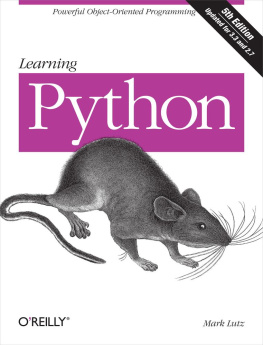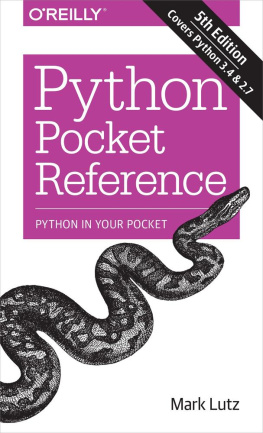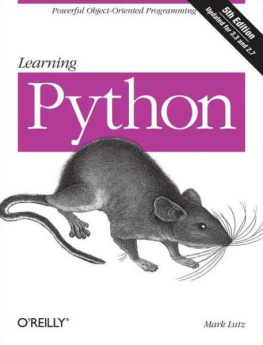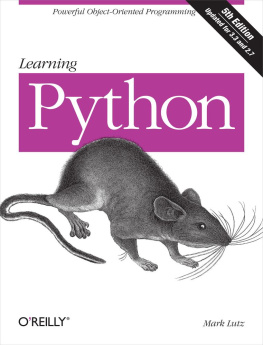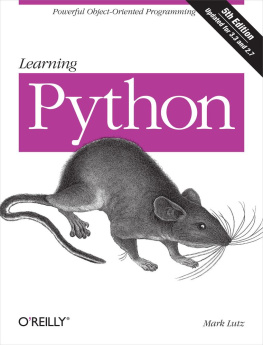Mark Lutz - Programming Python, Second Edition
Here you can read online Mark Lutz - Programming Python, Second Edition full text of the book (entire story) in english for free. Download pdf and epub, get meaning, cover and reviews about this ebook. year: 2018, publisher: OReilly Media, Inc., genre: Computer. Description of the work, (preface) as well as reviews are available. Best literature library LitArk.com created for fans of good reading and offers a wide selection of genres:
Romance novel
Science fiction
Adventure
Detective
Science
History
Home and family
Prose
Art
Politics
Computer
Non-fiction
Religion
Business
Children
Humor
Choose a favorite category and find really read worthwhile books. Enjoy immersion in the world of imagination, feel the emotions of the characters or learn something new for yourself, make an fascinating discovery.
Programming Python, Second Edition: summary, description and annotation
We offer to read an annotation, description, summary or preface (depends on what the author of the book "Programming Python, Second Edition" wrote himself). If you haven't found the necessary information about the book — write in the comments, we will try to find it.
Programming Python, Second Edition — read online for free the complete book (whole text) full work
Below is the text of the book, divided by pages. System saving the place of the last page read, allows you to conveniently read the book "Programming Python, Second Edition" online for free, without having to search again every time where you left off. Put a bookmark, and you can go to the page where you finished reading at any time.
Font size:
Interval:
Bookmark:
Copyright 2001 O'Reilly Media, Inc.

Less than five years ago, I wrote the Foreword for the first edition of Programming Python. Since then, the book has changed about as much as the language and the Python community! I no longer feel the need to defend Python: the statistics and developments listed in Marks Preface speak for themselves.
In the past year, Python has made great strides. We released Python 2.0, a big step forward, with new standard library features such as Unicode and XML support, and several new syntactic constructs, including augmented assignment: you can now write x += 1 instead of x = x+1. A few people wondered what the big deal was (answer: instead of x, imagine dict[key] or list[index]), but overall this was a big hit with those users who were already used to augmented assignment in other languages.
Less warm was the welcome for the extended print statement, print>>file, a shortcut for printing to a different file object than standard output. Personally, its the Python 2.0 feature I use most frequently, but most people who opened their mouths about it found it an abomination. The discussion thread on the newsgroup berating this simple language extension was one of the longest ever-apart from the never-ending Python versus Perl thread.
Which brings me to the next topic. (No, not Python versus Perl. There are better places to pick a fight than a Foreword.) I mean the speed of Pythons evolution, a topic dear to the heart of the author of this book. Every time I add a feature to Python, another patch of Marks hair turns gray-there goes another chapter out of date! Especially the slew of new features added to Python 2.0, which appeared just as he was working on this second edition, made him worry: what if Python 2.1 added as many new things? The book would be out of date as soon as it was published!
Relax, Mark. Python will continue to evolve, but I promise thatI wont remove things that are in active use! For example, there was alot of worry about the string module. Now that string objects havemethods, the string module is mostly redundant. I wish I could declareit obsolete (or deprecated) to encourage Python programmers to startusing string methods instead. But given that a large majority ofexisting Python code-even many standard library modules-imports thestring module, this change is obviously not going to happenovernight. The first likely opportunity to remove the string modulewill be when we introduce Python 3000; and even at that point, therewill probably be a string module in the backwards compatibilitylibrary for use with old code.
Python 3000?! Yes, thats the nickname for the next generation of the Python interpreter. The name may be considered a pun on Windows 2000, or a reference to Mystery Science Theater 3000, a suitably Pythonesque TV show with a cult following. When will Python 3000 be released? Not for a loooooong time-although you wont quite have to wait until the year 3000.
Originally, Python 3000 was intended to be a complete rewrite and redesign of the language. It would allow me to make incompatible changes in order to fix problems with the language design that werent solvable in a backwards compatible way. The current plan, however, is that the necessary changes will be introduced gradually into the current Python 2.x line of development, with a clear transition path that includes a period of backwards compatibility support.
Take, for example, integer division. In line with C, Python currently defines x/y with two integer arguments to have an integer result. In other words, 1/2 yields 0! While most dyed-in-the-wool programmers expect this, its a continuing source of confusion for newbies, who make up an ever-larger fraction of the (exponentially growing) Python user population. From a numerical perspective, it really makes more sense for the / operator to yield the same value regardless of the type of the operands: after all, thats what all other numeric operators do. But we cant simply change Python so that 1/2 yields 0.5, because (like removing the string module) it would break too much existing code. What to do?
The solution, too complex to describe here in detail, will have to span several Python releases, and involves gradually increasing pressure on Python programmers (first through documentation, then through deprecation warnings, and eventually through errors) to change their code. By the way, a framework for issuing warnings will be introduced as part of Python 2.1. Sorry, Mark!
So dont expect the announcement of the release of Python 3000 any time soon. Instead, one day you may find that you are already using Python 3000-only it wont be called that, but rather something like Python 2.8.7. And most of what youve learned in this book will still apply! Still, in the meantime, references to Python 3000 will abound; just know that this is intentionally vaporware in the purest sense of the word. Rather than worry about Python 3000, continue to use and learn more about the Python version that you do have.
Id like to say a few words about Pythons current development model. Until early 2000, there were hundreds of contributors to Python, but essentially all contributions had to go through my inbox. To propose a change to Python, you would mail me a context diff, which I would apply to my work version of Python, and if I liked it, I would check it into my CVS source tree. (CVS is a source code version management system, and the subject of several books.) Bug reports followed the same path, except I also ended up having to come up with the patch. Clearly, with the increasing number of contributions, my inbox became a bottleneck. What to do?
Fortunately, Python wasnt the only open source project with this problem, and a few smart people at VA Linux came up with a solution: SourceForge! This is a dynamic web site with a complete set of distributed project management tools available: a public CVS repository, mailing lists (using Mailman, a very popular Python application!), discussion forums, bug and patch managers, and a download area, all made available to any open source project for the asking.
We currently have a development group of 30 volunteers with SourceForge checkin privileges, and a development mailing list comprising twice as many folks. The privileged volunteers have all sworn their allegiance to the BDFL (Benevolent Dictator For Life-thats me :-). Introduction of major new features is regulated via a lightweight system of proposals and feedback called Python Enhancement Proposals (PEPs). Our PEP system proved so successful that it was copied almost verbatim by the Tcl community when they made a similar transition from Cathedral to Bazaar.
So, it is with confidence in Pythons future that I give the floor to Mark Lutz. Excellent job, Mark. And to finish with my favorite Monty Python quote: Take it away, Eric, the orchestra leader!
| Guido van Rossum |
| Reston, Virginia, January 2001 |
The first edition of this book was one of the first to present thePython language. This second edition is an almost completely newadvanced Python topics book, designed to be a follow-up to the corelanguage material in Learning Python andsupplemented by the reference material in Python Pocket Reference .
That is, this edition is focused on ways to use
Font size:
Interval:
Bookmark:
Similar books «Programming Python, Second Edition»
Look at similar books to Programming Python, Second Edition. We have selected literature similar in name and meaning in the hope of providing readers with more options to find new, interesting, not yet read works.
Discussion, reviews of the book Programming Python, Second Edition and just readers' own opinions. Leave your comments, write what you think about the work, its meaning or the main characters. Specify what exactly you liked and what you didn't like, and why you think so.

